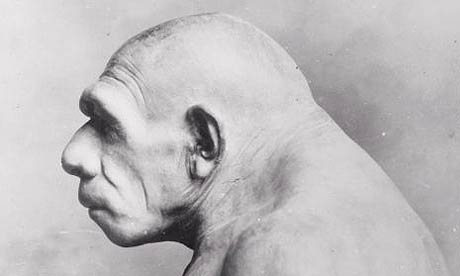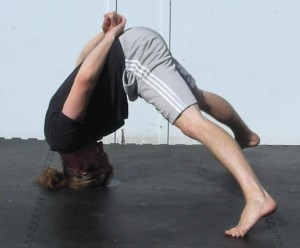The neck is often under appreciated There’s a saying: where the head goes, the body follows. This is especially true when you’re tricking, spinning, and twisting all over the place. A strong neck never hurts. It can make for safer tricking (if you ever fall on your neck, you’ll have some protective strength to save your [...]

The neck is often under appreciated There’s a saying: where the head goes, the body follows. This is especially true when you’re tricking, spinning, and twisting all over the place.
A strong neck never hurts. It can make for safer tricking (if you ever fall on your neck, you’ll have some protective strength to save your spinal column from combustion [in all seriousness, this wouldn’t happen anyway — but having neck strength is good regardless…] ) and to be all around badass.
Don’t worry. I got a plan for you. Logan Christopher will light the way.
The following is a guest post by Logan Christopher of The Lost Art of Handbalancing:
Neck strength is one of my specialties. People think neck training hurts their neck. But it does the opposite: makes it much, much stronger. That’s why I do it.
I have some personal experiences to back this up. During a football game I played in Spain, my head smacked pretty hard into the ground. Aside from being slightly concussed, I made it out alive. Without neck training, I fear it would have been much worse.
There are plenty of neck exercises out there. People use harnesses. Weights. Weights attached to harnesses. Bands. Even their own hand for isometric resistance.
But my preferred form of training?
Bridging.
Taken beyond a “normal” level, that is. (And yes, it brings me joy when people tell me I’m going to break my neck during these exercises.) So what follows is my thoughts on the wrestler’s bridge and front bridge. (The gymnastics bridge is equally important for purposes beyond neck strength.)
The Wrestlers Bridge Progressions
Wrester’s Bridge with Hands

The wrestler’s bridge is typically used by wrestlers, hence the name. Unfortunately, this exercise scares many people because the neck muscles are under considerable stress. But have no fear. With the proper progression, they can handle the load.
Start on your back. Bring your hands to the sides of your head with the fingertips pointed back towards your feet. Bring your feet up about shoulder width, so the knees are bent 90 degrees. Using your hands for help, roll up onto the top of your head. As in the hip bridge, bring your hips as high as they can go.
With the wrestler’s bridge, start on the top of your head. To build more neck strength and flexibility you can then work towards the forehead on the mat. You can go as far as touching your nose to the ground, but I wouldn’t work any further unless you plan on becoming a contortionist.
Work up to one minute in this position, and if you choose you can go much longer. But if you get to one minute you’ll probably be safe to move onto the next drill.
Wrestler’s Bridge without Hands

Now we’re going to up the intensity by removing the hands. This requires the muscles of the neck to take on the rest of your body weight in this position. This can be worked into slowly by just applying less and less pressure with your hands with the first variation over time.
Get into the same position as the wrestler’s bridge with the hands. Now raise your hands off the floor and fold them across your chest. Work up to one minute in this position and if you choose you can go much longer.
Wrestler’s Bridge Rollups
While the first two exercises are isometric positions, this exercise is dynamic. It looks similar to what we’ve already been doing but there is a key difference. In fact, this was a favorite neck strengthening exercise of old time strongman George F. Jowett.
Start on your back with your arms folded across your chest. Knees bent, feet flat against the ground.
Using your neck strength alone, roll up to the top of your head. Do not push with your legs or use momentum to do it.
Repeat for reps. Shoot for 30. When you can do that, you’re on the right path.
Bridge Weight Support

Scaling time gets boring. My all time best for holding a hands free wrestler’s bridge is ten minutes. Who wants to hold a position for ten minutes? Didn’t think I’d see any hands. So the next progression is to add weight.
Start with a dumbbell or kettlebell. Get into position and hold it overhead. Then move to a bell in each hand. Then a barbell. (Supported in a rack if need be.)
Note: this is a very advanced exercises. Spend lots of time on the previous progression before adding weight. Lots. You don’t all-of-the-sudden support 600 pounds in the bridge position.
Front Bridge

After the wrestler’s bridge, it’s wise to work the neck in the opposite direction. If one exercise makes you go “that way,” do another that makes you go the other way.
Bend forward at the hips and place the crown of your head on the ground. Use your hands on the ground when you first begin, but you should be able to perform this move without them in no time. Your legs should be spread apart so that they form a tripod along with your head.
Roll your head so that your chin touches your chest. Resting your weight towards the back of the head, you should feel an intense stretch across the back of your neck. This is the normal position. Hold for time.
Front Neck Plank

One day I decided to make the front bridge more difficult. Moving onto the forehead first I went from the straddled leg position to feet together. From there I walked my feet away from my body until I was fully extended with just my forehead and toes touching the ground. Work up to this slowly. And not only will this move strengthen your neck greatly but it will work your core too.
This really works the front of the neck. Hold for time. I generally just do 20-30 seconds in this position. I could go longer but instead I isometrically push my forehead into the ground to add to resistance.
Putting it all together – Sample Workout
When it comes to neck strength my workout is simple: one work set for the wrestler’s bridge followed by the front neck plank. (Warm-ups not included in the “one set” designation.) So hold the wrestler’s bridge for time for a single set followed by the front bridge. This simple format has done me much good over the years and allowed me to build neck strength far above the average person.
And if that’s too complex for you…well…no one can save you. Give it a shot and be sure to let me know how it goes for you.
Logan Christopher runs Legendary Strength, which is devoted to body weight, kettlebell, and strongman training, and Lost Art of Hand Balancing. Take a guess what that site is about. Here’s a hint: how to do handstands and acrobatic skills.